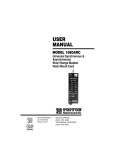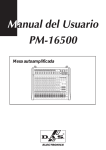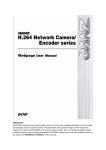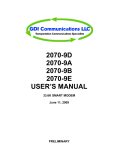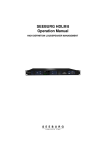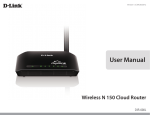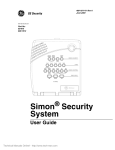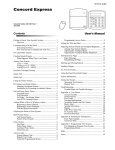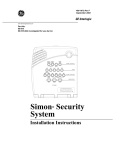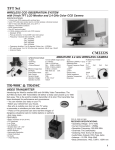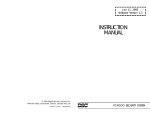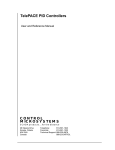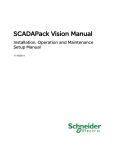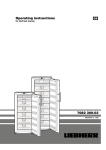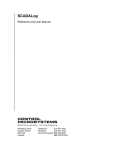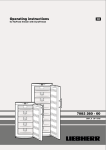Download 5902 Bell 202 Modem
Transcript
5902 Bell 202 Modem Installation, Operation and Maintenance Setup Manual 5/19/2011 Safety Information The information provided in this documentation contains general descriptions and/or technical characteristics of the performance of the products contained herein. This documentation is not intended as a substitute for and is not to be used for determining suitability or reliability of these products for specific user applications. It is the duty of any such user or integrator to perform the appropriate and complete risk analysis, evaluation and testing of the products with respect to the relevant specific application or use thereof. Neither Schneider Electric nor any of its affiliates or subsidiaries shall be responsible or liable for misuse of the information contained herein. If you have any suggestions for improvements or amendments or have found errors in this publication, please notify us. No part of this document may be reproduced in any form or by any means, electronic or mechanical, including photocopying, without express written permission of Schneider Electric. All pertinent state, regional, and local safety regulations must be observed when installing and using this product. For reasons of safety and to help ensure compliance with documented system data, only the manufacturer should perform repairs to components. When devices are used for applications with technical safety requirements, the relevant instructions must be followed. Failure to use Schneider Electric software or approved software with our hardware products may result in injury, harm, or improper operating results. Failure to observe this information can result in injury or equipment damage. © 2010 Schneider Electric. All rights reserved. Document (Version 2.24.1.84) 5/19/2011 2 Safety Information Table of Contents Safety Information .........................................................................5 About The Book .............................................................................8 At a Glance ............................................................................................................ 8 Overview .........................................................................................9 Industry Canada Certification .....................................................10 Installation ....................................................................................12 Connecting the Modem ........................................................................................ 12 Field Wiring .......................................................................................................... 13 Connecting to Dedicated Lines ............................................................................ 16 Connecting to a Radio ......................................................................................... 20 Configuration Switches ........................................................................................ 22 Operation ......................................................................................28 Full Duplex ........................................................................................................... 28 Half Duplex ........................................................................................................... 28 Sample Configurations ......................................................................................... 31 System Configuration Procedures ....................................................................... 34 Troubleshooting and Solutions ............................................................................ 36 LED Indicators ...................................................................................................... 40 F Option ............................................................................................................... 40 M Option ............................................................................................................... 41 Maintenance .................................................................................43 Gain Adjustments ................................................................................................. 43 Modem Test Modes ............................................................................................. 44 Troubleshooting ................................................................................................... 46 Specifications ..............................................................................47 Approvals and Certifications ......................................................49 Document (Version 2.24.1.84) 5/19/2011 3 Safety Information Index of Figures Figure 1: 5902 Module Layout ........................................................................... 13 Figure 2: RS-232 Port Connector (DCE)............................................................ 13 Figure 3: RS-232 Wiring - 5902 (DCE) to DTE .................................................. 15 Figure 4: Four Wire Network .............................................................................. 17 Figure 5: Two Wire Network .............................................................................. 17 Figure 6: Four Wire RJ-45 Connection .............................................................. 18 Figure 7: Two Wire RJ-45 Connection ............................................................... 18 Figure 8: Four Wire Terminal Block Connection ................................................ 19 Figure 9: Two Wire Terminal Block Connection ................................................. 19 Figure 10: Typical Connection to Maxon Radio ................................................. 21 Figure 11: Typical Connection to Johnson Radio ............................................... 21 Figure 12: Typical Connection to Motorola Radio .............................................. 22 Figure 13: Transmit Timing with Soft Carrier Turnoff ......................................... 29 Figure 14: Receive Timing without Soft Carrier Turn-off .................................... 30 Figure 15: Receive Timing with Soft Carrier Turn-off ......................................... 31 Document (Version 2.24.1.84) 5/19/2011 4 Safety Information Safety Information Read these instructions carefully, and look at the equipment to become familiar with the device before trying to install, operate, or maintain it. The following special messages may appear throughout this documentation or on the equipment to warn of potential hazards or to call attention to information that clarifies or simplifies a procedure. The addition of this symbol to a Danger or Warning safety label indicates that an electrical hazard exists, which will result in personal injury if the instructions are not followed. This is the safety alert symbol. It is used to alert you to potential personal injury hazards. Obey all safety messages that follow this symbol to avoid possible injury or death. DANGER DANGER indicates an imminently hazardous situation which, if not avoided, will result in death or serious injury. WARNING WARNING indicates a potentially hazardous situation which, if not avoided, can result in death or serious injury. CAUTION CAUTION indicates a potentially hazardous situation which, if not avoided, can result in minor or moderate. CAUTION CAUTION used without the safety alert symbol, indicates a potentially hazardous situation which, if not avoided, can result in equipment damage.. Document (Version 2.24.1.84) 5/19/2011 5 Safety Information PLEASE NOTE Electrical equipment should be installed, operated, serviced, and maintained only by qualified personnel. No responsibility is assumed by Schneider Electric for any consequences arising out of the use of this material. A qualified person is one who has skills and knowledge related to the construction and operation of electrical equipment and the installation, and has received safety training to recognize and avoid the hazards involved. BEFORE YOU BEGIN Do not use this product on machinery lacking effective point-of-operation guarding. Lack of effective point-of-operation guarding on a machine can result in serious injury to the operator of that machine. CAUTION EQUIPMENT OPERATION HAZARD Verify that all installation and set up procedures have been completed. Before operational tests are performed, remove all blocks or other temporary holding means used for shipment from all component devices. Remove tools, meters, and debris from equipment. Failure to follow these instructions can result in injury or equipment damage. Follow all start-up tests recommended in the equipment documentation. Store all equipment documentation for future references. Software testing must be done in both simulated and real environments. Verify that the completed system is free from all short circuits and grounds, except those grounds installed according to local regulations (according to the National Electrical Code in the U.S.A, for instance). If high-potential voltage testing is necessary, follow recommendations in equipment documentation to prevent accidental equipment damage. Before energizing equipment: Remove tools, meters, and debris from equipment. Close the equipment enclosure door. Remove ground from incoming power lines. Perform all start-up tests recommended by the manufacturer. OPERATION AND ADJUSTMENTS The following precautions are from the NEMA Standards Publication ICS 7.11995 (English version prevails): Document (Version 2.24.1.84) 5/19/2011 6 Safety Information Regardless of the care exercised in the design and manufacture of equipment or in the selection and ratings of components, there are hazards that can be encountered if such equipment is improperly operated. It is sometimes possible to misadjust the equipment and thus produce unsatisfactory or unsafe operation. Always use the manufacturer’s instructions as a guide for functional adjustments. Personnel who have access to these adjustments should be familiar with the equipment manufacturer’s instructions and the machinery used with the electrical equipment. Only those operational adjustments actually required by the operator should be accessible to the operator. Access to other controls should be restricted to prevent unauthorized changes in operating characteristics. Document (Version 2.24.1.84) 5/19/2011 7 About The Book About The Book At a Glance Document Scope This manual describes operation and maintenance of the 5902 Bell 202 modem. Validity Notes This document is valid for all versions of the 5902 Bell 202 modem. Product Related Information WARNING UNINTENDED EQUIPMENT OPERATION The application of this product requires expertise in the design and programming of control systems. Only persons with such expertise should be allowed to program, install, alter and apply this product. Follow all local and national safety codes and standards. Failure to follow these instructions can result in death, serious injury or equipment damage. User Comments We welcome your comments about this document. You can reach us by e-mail at [email protected]. Document (Version 2.24.1.84) 5/19/2011 8 Overview Overview The model 5902 Bell 202 modem converts RS-232 signal levels to audio tones for transmission over radios, two wire networks, four wire multi-point networks, and four wire point-to-point networks. The modem is transformer isolated from the communication system, so it is well suited to applications which may experience transients, static discharges, or high common-mode voltages. Radio communication is facilitated by an isolated radio transmitter key output, and a radio frequency carrier detect input. The input can be used to inhibit transmission if a radio signal is detected. Each signal can be wired for active high or active low signals. Configurable carrier detect and loss delays, and RTS/CTS delays provide high quality communication in a broad variety of environments. The anti-streaming timer keeps a continuously keyed modem from swamping the communication system. Configuration switches permit adjustment of carrier detection and loss delays, anti-streaming time, soft-carrier turn-off tones, RTS/CTS handshake timing, and full/half duplex selection. Self test and adjustment modes facilitate field maintenance. Two package versions are available. The model 5902 modem is a DIN rail mounted version for SCADAPack controllers. The model 5902SA is a desktop version for with personal computers and other RS-232 equipment. This manual covers the 5902 modem. Document (Version 2.24.1.84) 5/19/2011 9 Industry Canada Certification Industry Canada Certification The model 5902 modem is registered with Industry Canada as complying with standard CS02. The certification number is on a sticker attached to the unit. Industry Canada requires that the following information be conveyed to the user. NOTICE: The Industry Canada label identifies certified equipment. This certification means that the equipment meets certain telecommunications network protective, operational and safety requirements. Industry Canada does not guarantee the equipment will operate to the user’s satisfaction. Before installing this equipment, users should ensure that it is permissible to be connected to the facilities of the local telecommunications company. The equipment must also be installed using an acceptable method of connection. The customer should be aware that the compliance with the above conditions may not prevent degradation of service in some situations. Repairs to certified equipment should be made by an authorized Canadian maintenance facility designated by the supplier. Any repairs or alternations made by the user to this equipment, or equipment malfunctions, may give the telecommunications company cause to request the user to disconnect the equipment. Users should ensure for their own protection that the electrical ground connections of the power utility, telephone lines and internal metallic water pipe system, if present, are connected together. This precaution may be particularly important in rural areas. CAUTION: Users should not attempt to make such connections themselves, but should contact the appropriate electric inspection authority, or electrician, as appropriate. Document (Version 2.24.1.84) 5/19/2011 10 Industry Canada Certification AVIS: L’étiquette de l'Industrie Canada identifie le matériel homologué. Cette étiquette certifie que le matériel est conforme à certaines normes de protection, d’exploitation et de sécurité des réseaux de télécommunications. Industrie Canada n’assure toutefois pas que le matériel fonctionnera à la satisfaction de l’utilisateur. Avant d’installer ce matériel, l’utilisateur doit s’assurer qu’il est permis de le raccorder aux installations de l’entreprise locale de télécommunication. Le matériel doit également être installé en suivant une méthod acceptée de raccordement. L’abonné ne doit pas oublier qu’il est possible que la conformité aux conditions énoncées ci-dessus n’empêchent pas la dégradation du service dans certaines situations. Les réparations de matériel homologué doivent être effectuées par un centre d’entretien canadien autorisé, désigné par le fournisseur. La compagnie de télécommunications peut demander à l’utilisateur de débrancher un appareil à la suite de réparations ou de modifications effectuées par l’utilisateur ou a cause de mauvais fonctionnement. Pour sa propre protection, l’utilisateur doit s’assurer que tous les fils de mise à la terre de la source d’énergie électrique, les lignes téléphoniques et les canalisations d’eau métalliques, s’il y en a, sont raccordés ensemble. Cette précaution est particulièrement importante dans les régions rurales. AVERTISSEMENT: Document (Version 2.24.1.84) 5/19/2011 L’utilisateur ne doit pas tenter de faire ces raccordements lui-même; il doit avoir recours à un service d’inspection des installations électriques, ou à un électricien, selon le cas. 11 Installation Installation The installation of the 5902 modem requires mounting the modem on the 7.5mm by 35mm DIN rail and connecting the 5902 modem to the system I/O Bus. Refer to the System Configuration Guide, at the beginning of this manual, for complete information on system layout, I/O Bus cable routing and 5902 modem installation. Connecting the Modem The 5902 modem is normally connected to the SCADAPack I/O Bus through the I/O Bus Connectors as shown in figure 1.In this configuration the SCADAPack provides a modem reset (/RST) signal and a signal to enable the leds (LEDON) on the 5902 modem. The 5902 modem is also available in a standalone (SA) configuration. In this configuration the 5902 is not connected to a SCADAPack controller and the modem reset (/RST) signal and a signal to enable the leds (LEDON) on the 5902 modem are not available. Two jumpers, J1 and J2, are included to enable these signals on the 5902SA modem. Figure 1: 5902 Module Layout shows the location of the jumpers. 5902 Modem Remove jumper at J1 (/RST). Remove jumper at J2 (LEDON). 5902SA Modem Install jumper at J1 (/RST). Install jumper at J2 (LEDON). Document (Version 2.24.1.84) 5/19/2011 12 Installation Status LEDs I/O Bus Connector I/O Bus Connector Configuration Switches LEDON Jumper (J2) RX Gain Adjustment TX Gain Jumper (J3) /RST Jumper (J1) TX Gain Adjustment RJ-45 Jack Termination Block RS-232 DCE Connector + –+ –+ –+ – Tx/Rx Rx KEY RCD Figure 1: 5902 Module Layout Field Wiring The 5902 modem has three connectors for field wiring. The RS-232 port is wired to the DE-9S socket connector. Refer to section RS-232 Serial Port for more information. The modem wiring is terminated on either an 8 pole terminal block or an RJ-45 modular jack. The terminal block is used for radios, private lines and leased telephone lines. The jack is used typically for telephone lines. Refer to section Terminal Block and RJ-45 Modular Jack for more information. The modem operates on radios, two wire networks, four wire multi-point networks, and four wire point-to-point networks. Section Connecting to Dedicated Lines describes wiring networks on dedicated lines. Section Connecting to a Radio describes wiring to radios. RS-232 Serial Port 5 Gnd 4 DTR 9 5V 3 TxD 8 CTS 2 RxD 7 RTS 1 DCD 6 DSR Figure 2: RS-232 Port Connector (DCE) Document (Version 2.24.1.84) 5/19/2011 13 Installation The RS-232 port is a 9-pin female D-sub-miniature connector (DE-9S) configured as Data Communications Equipment (DCE). A maximum cable length of 50 feet (15.2 m) is allowed. Figure 2: RS-232 Port Connector (DCE) and the table below describe the RS-232 connector. In the following table a MARK is a voltage of +3 volts or greater; a SPACE is a voltage of –3 volts or less. Pin Type Description Pin1 DCD output Pin 2 RxD output Pin 3 TxD input Pin 4 DTR Pin 5 Ground Pin 6 DSR Pin 7 RTS input This signal is at a MARK level when carrier is detected by the modem on the receiver inputs. The CD led is on for a MARK level. Data received by the modem is output on this pin. The level is SPACE on standby and MARK for received data. The RD LED is lit for a MARK level. Data transmitted by the modem is input on this pin from the DTE. The level is SPACE on standby and MARK for transmitted data. The TD LED is lit for a MARK level. This signal indicates that the DTE is ready to receive data. It is not used by the modem. Pin 8 CTS output Pin 9 5 Volt Power input/ output This pin is connected to the I/O system ground. output This signal indicates the modem is ready to start communication. It is in a MARK state. input A MARK level is required for the modem to transmit data. The DTE should set it to a MARK just before transmission of data. The CTS output will be asserted when the modem is ready to transmit data. The RS LED is ON for a MARK level. This output indicates the modem is ready to transmit data. A MARK level indicates the modem is ready. The DTE should wait for this signal before transmitting data. The CS LED is on for a MARK level. This pin is connected to the 5V power supply. It is a power source for an external device when used as an output. It powers the modem when used as an input. RS-232 wiring uses shielded cable. The shield should be connected to chassis ground at one end of the cable only. The DE-9 connector shell is a good ground point. Improperly shielded cables may result in the installation not complying with FCC or DOC radio interference regulations. The 5902 modem is connected typically to a DTE device. Figure 3: RS-232 Wiring - 5902 (DCE) to DTE shows a typical connection. Document (Version 2.24.1.84) 5/19/2011 14 Installation The serial cable that is provided with the 5902 modem is suitable for connecting the modem to a Data Communication Equipment (DCE) device. DTE 5902 (DCE) DCD 1 DCD RxD 2 RxD TxD 3 TxD DTR 4 DTR GND 5 GND 6 RTS 7 RTS CTS 8 CTS See device specifications for pin numbers Pin 9 is a connected to the 5 Volt power supply. 9 5 Volt Figure 3: RS-232 Wiring - 5902 (DCE) to DTE Terminal Block Field wiring for radios and dedicated lines connects to the terminal block. It has 8 poles: Poles 1 and 2 are the transmit pair for 4-wire mode and the transmit/receive for 2-wire mode. Poles 3 and 4 are the receive pair for 4-wire mode. Poles 5 and 6 are the radio key output. Poles 7 and 8 are the radio carrier detect input. Controller, modem and I/O modules use screw termination style connectors for termination of field wiring. They accommodate solid or stranded wires from 22 to 12 AWG. The connectors are removable. This allows module replacement without disturbing the field wiring. Leave enough slack in the wiring for the connector to be removed. Remove power before servicing unit. To remove the connector: Pull the connector upward from the board. Apply even pressure to both ends of the connector. To install the connector: Line up the pins on the module with the holes in the connector. Document (Version 2.24.1.84) 5/19/2011 15 Installation Push the connector onto the pins. Apply even pressure to both ends on the connector. Refer to section Connecting to Dedicated Lines for wiring diagrams for typical networks. Refer to section Connecting to a Radio for wiring diagrams for common radios. RJ-45 Modular Jack Field wiring for telephone lines connects to the RJ-45 modular jack. It mates with an 8 pin modular plug with at least 4 contacts. This type of connector is common in the telephone industry. Pins 4 and 5 are the transmit pair for 4-wire mode and the transmit/receive for 2-wire mode. Pins 3 and 6 are the receive pair for 4-wire mode. Pins 1, 2, 7 and 8 are not used. Refer to section Connecting to Dedicated Lines for wiring diagrams for typical networks. Connecting to Dedicated Lines The 5902 modem operates in full duplex on four wire networks, or in half duplex on two wire networks. It uses leased telephone lines or private lines. Four wire mode Four wire operation uses one pair of wires for transmitting data and a second pair for receiving data. The transmitting pair are connected to the +TX and –TX. The receiving pair are connected to the +RX and –RX terminals. Figure 4: Four Wire Network shows a typical 4 wire network. Figure 6: Four Wire RJ-45 Connection and Figure 8: Four Wire Terminal Block Connection give wiring details. Two wire mode Two wire operation uses one pair of wires for transmitting and receiving data. The field wiring connects to the +Tx/Rx and –Tx/Rx terminals. Figure 5: Two Wire Network shows a typical 2 wire network. Figure 7: Two Wire RJ-45 Connection and Figure 9: Two Wire Terminal Block Connection give wiring details. Document (Version 2.24.1.84) 5/19/2011 16 Installation MASTER MASTER –RX --Tx/Rx + RX + Tx/Rx –TX + TX SLAVE SLAVE –RX --Tx/Rx + RX + Tx/Rx –TX + TX SLAVE SLAVE –RX --Tx/Rx + RX + Tx/Rx –TX + TX SLAVE SLAVE –RX --Tx/Rx + RX + Tx/Rx –TX + TX Figure 4: Four Wire Network Document (Version 2.24.1.84) 5/19/2011 Figure 5: Two Wire Network 17 Installation RJ-45 Modular Jack 1 2 3 4 5 6 7 8 4 Wire Conections 1. no connection 2. no connection 3. + Rx 4. + Tx 5. –Tx 6. –Rx 7. no connection 8. no connection Tx pair to slaves Rx pair from slaves Figure 6: Four Wire RJ-45 Connection RJ-45 Modular Jack 1 2 3 4 5 6 7 8 2 Wire Connections 1. no connection 2. no connection 3. no connection 4. + Tx/Rx 5. –Tx/Rx 6. no connection 7. no connection 8. no connection Tx/Rx pair Figure 7: Two Wire RJ-45 Connection Document (Version 2.24.1.84) 5/19/2011 18 Installation 5902 Termination Block Tx/Rx Rx KEY RCD + – + – + – + – 1 2 3 4 5 6 7 8 Tx pair to slaves Rx pair from slaves Figure 8: Four Wire Terminal Block Connection 5902 Termination Block Tx/Rx Rx KEY RCD + – + – + – + – 1 2 3 4 5 6 7 8 Tx/Rx pair Figure 9: Two Wire Terminal Block Connection Document (Version 2.24.1.84) 5/19/2011 19 Installation Connecting to a Radio There are four signals that are connected for radios. These signals are described below. Refer to the manual supplied with your radio for more information. Wiring diagrams are provided for several common radios. Call Control Microsystems if you require assistance in connecting a radio not described here. Modem Transmitter Output The modem transmitter output connects to the radio transmitter audio input. The modem is factory calibrated with the transmitter output at 0 dBm. This level is too high for many radios. It is necessary to reduce the modem output by adjusting the TX GAIN potentiometer (see section Gain Adjustments). The transmitter output can be reduced to a level radios can accept. If additional attenuation is required, an external resistor voltage divider may be used. Modem Receiver Input The modem receiver input connects to the radio receiver data output. The modem is factory calibrated with the receiver input set to detect signals as low as –30dBm. Radios provide output signals well above this level, so no adjustment of the RX GAIN potentiometer should be necessary. Key Output The KEY output is an optically isolated transistor, which is used to turn on a radio transmitter. It is referred to as a keyline or PTT (push to talk) signal in radio manuals. When using the KEY output. Observe the polarity of the KEY output. Limit the output current to 25mA during the on condition. Limit the output voltage to 15 volts during the off condition. The KEY output is on (capable of conducting current) during transmission of carrier tones and data. Radio Carrier Detect Input The Radio Carrier Detect (RCD) input keeps the modem from keying a radio transmitter when RF carrier is detected. This keeps one radio from transmitting over another. It is highly recommended that radio applications make use of the RCD input. The RCD input enables the modem receiver only when a radio frequency carrier is present, when the RCD switch is closed. This minimizes bad data caused by an unsquelched radio. If a radio does not squelch its audio, use of the RCD input is mandatory for communication. Wiring Diagrams Wiring diagrams are provided for the following radios. Refer to the manual supplied with your radio for more information. Document (Version 2.24.1.84) 5/19/2011 20 Installation Maxon DM-0500 E.F. Johnson models 3410/3490 Motorola RNet 5902 Termination Block Tx/Rx Rx KEY RCD + – + – + – + – 1 2 3 4 5 6 7 8 + 10.8 Volts – 1 2 6 3 7 4 8 Maxon D Connector 1. data in 2. data out 3. PTT 4. GND 5. Vcc 6. CDS 7. no connection 8. no connection 9. no connection 5 9 Figure 10: Typical Connection to Maxon Radio 5902 Termination Block Tx/Rx Rx KEY RCD + – + – + – + – 1 2 3 4 5 6 7 8 + Power Supply – 5 8 10 6 Johnson models 3410/3490 10 pin connector 7 9 Johnson Connector Pins 1. no connection 2. no connection 3. no connection 4. no connection 5. B+ 6. Keyline (active low) 7. Carrier Detect (active high) 8. Data In 9. Ground 10. Data out Figure 11: Typical Connection to Johnson Radio Document (Version 2.24.1.84) 5/19/2011 21 Installation 5902 Termination Block Tx/Rx Rx KEY RCD + ---- + ---- + ---- + ---1 2 3 4 5 6 7 8 + Power Supply ---- 6 7 Connections shown for: Carrier detect active high PTT active low Channel 1 enabled Squelch enabled 8 14 13 15 Motorola RNet Series Telemetry Radio 15 pin D-connector Motorola Connector Pins 1. Not Used 2. Not Used 3. Not Used 4. Mic Audio Input 5. Channel Select 6. B+ 7. Data Input 8. Data Output 9. Not Used 10. Not Used 11. Squelch Disable 12. Audio Output 13. Carrier Detect 14. PTT 15. Ground Figure 12: Typical Connection to Motorola Radio Configuration Switches The 5902 modem has 16 configuration switches. They specify the modem communication parameters and operating modes. See Figure 1: 5902 Module Layout for switch locations. The functions are described in detail below. The switches can be changed with the power applied. All changes take effect immediately. To CLOSE a switch, press down on the right side of the switch. To OPEN a switch, press down on the left side of the switch. Using a pencil, mechanical pencil or pen to adjust the switches as graphite and ink can affect the switch. A paper clip is a good tool for adjusting switches. RTS/CTS Delay The CS0 and CS1 switches control the RTS/CTS delay. There are four options. The delays are longer when the RCD option is enabled, as radios usually require longer delays. DELAY (RCD open) DELAY (RCD closed) 25 ms 67 ms 50 ms 133 ms 125 ms 266 ms 250 ms 1000 ms CS0 switch CS1 switch open open closed open open closed closed closed The RTS and CTS signals coordinate data transmission between the modem and the DTE. When RTS is asserted by the DTE, the modem turns on its carrier, keys the radio and starts a delay. At the conclusion of the delay, CTS is asserted by the modem to allow the DTE to transmit data. This delay has different functions according to the modem duplex setting. Document (Version 2.24.1.84) 5/19/2011 22 Installation Half Duplex (FDX open) The RTS/CTS delay allows the modem carrier to be transmitted to and be detected by the receiving modem or modems. The receiving modem requires time to detect and synchronize to the carrier, before it can accept data. Radios may take some time to key up to rated power before transmitting. Radio repeaters also require time to engage. The RTS/CTS delay provides this time. When RTS is asserted by the DTE, the 5902 modem closes the KEY output, turns on the transmit carrier, and starts the delay. When the delay has expired, the modem asserts CTS to allow the DTE to transmit. The modem will not transmit carrier or start the RTS/CTS delay, while carrier is being received, unless constant carrier operation is selected (refer to section Carrier Loss Delay). This keeps the modem from transmitting at the same time as another modem. Full Duplex (FDX closed) The RTS/CTS delay has no effect on modem operation in full duplex mode. The modem continuously transmits a carrier. The RTS/CTS delay is functional and can be used to insert a pause between transmissions. To use this feature, the DTE device uses RTS/CTS handshaking (half duplex operation). When the DTE is ready to transmit data, it asserts RTS and waits for CTS to be asserted by the modem. When CTS is asserted, the DTE transmits the data. The DTE releases RTS at the end of transmission. This causes a pause before each transmission. Carrier Detect Delay The CD0 and CD1 switches control the carrier detect delay. There are four options. The delays are longer when the RCD option is enabled, as radios usually require longer delays. DELAY (RCD open) DELAY (RCD closed) 19 ms 33 ms 30 ms 67 ms 51 ms 133 ms 92 ms 265 ms CD0 switch CD1 switch Open Open closed open Open Closed closed closed The modem will not receive data until carrier is detected. The carrier detect period checks that a sustained carrier is present, before the receiver is enabled. The carrier detect delay stops noise from being received at the beginning of each reception. The carrier needs to be present for this period, before it is detected as carrier. If the carrier drops out during the detect period, it will not be detected as carrier. The carrier detect delay switch settings need to be less than the RTS/CTS delay of the transmitting modem, plus any propagation delays such as radio transmitter and radio receiver attack times. Document (Version 2.24.1.84) 5/19/2011 23 Installation Carrier Loss Delay The CL0 and CL1 switches control the carrier loss delay. There are four options. The duplex (FDX) switch affects the selection of one option (see section Duplex). CL DELAY (+/– 1.5 ms) 6 ms 10 ms 23 ms 39 ms FDX Constant Carrier HDX CL0 switch CL1 switch Open Open closed open open closed closed closed Carrier can be lost in the middle of a transmission, especially with radio communication. The carrier loss delay allows the carrier to disappear for brief intervals, without the loss causing the modem to test for the carrier detect delay when the carrier reappears. The carrier loss delay also determines how long the modem waits after reception terminates, before it allows transmission in half duplex mode. Therefore, the carrier loss delay is also a transmission turnaround delay for half duplex mode. Use With Constant Carrier Reception In constant carrier, half duplex (HDX) mode a carrier signal is continuously received on the receive pair, Rx + and Rx -. Selecting constant carrier reception mode allows the modem to transmit data on the transmit pair, Tx/Rx + and Tx/Rx -, even though received carrier is detected. Close switches CL0 and CL1 when connected to a constant carrier source in a four wire, half duplex system. Use With Full Duplex The carrier loss delay always functions in full duplex mode (see section Duplex). The constant carrier option is not available, since the modem can transmit at any time when in full duplex. Effect of Soft Carrier Turn-off Tones Reception of a soft carrier turn-off tone ends reception within the soft carrier turnoff detect time (see Specifications). The carrier loss delay is not used. The modem de-asserts the DCD output and turns off the CD LED when the SCT tone is received. Anti-Streaming The AS0 and AS1 switches control the anti-streaming option. There are four settings. ANTI-STREAMING TIME NONE 10 s 30 s 60 s AS0 switch AS1 switch open open closed open open closed closed closed Document (Version 2.24.1.84) 5/19/2011 24 Installation The anti-streaming time determines the maximum time a modem can continuously transmit. This stops a DTE from disabling a radio network or multidrop line by transmitting data continuously. If the DTE transmits longer than the anti-streaming time, the modem turns off the KEY output, and de-asserts the CTS and DCD signals to the DTE. The modem remains in this state until the DTE de-asserts RTS. The modem returns to normal operation once RTS is de-asserted. Anti-streaming is active only when the modem is configured for half duplex operation. It ignores anti-streaming in full duplex operation. Soft Carrier Turn-off Switches SC0 and SC1 control the length of the soft carrier turn-off (SCT) tone. There are four options. SCT Tone Length (+/– 1 ms) No Tone 13 ms 25 ms 38 ms SC0 switch SC1 switch open open closed open open closed closed closed The modem can transmit a soft carrier turn-off (SCT) tone to inform receiving modems to turn off their receivers. The tone is transmitted at the end of a transmission. It stops the receivers from detecting a noise burst at the conclusion of each transmission The tone can be disabled if the receiving modem does not recognize the SCT tone. The modem de-asserts the CTS signal when transmitting the SCT tone. An asserted RTS signal will not be recognized until the SCT time has concluded. Half duplex and two wire applications should use the shortest functional (nonzero) SCT tone, to get the quickest turn around time possible. The modem will not transmit while the SCT tone is being received. Soft Carrier Turn-off Reception The modem recognizes the soft carrier turn-off tone, regardless of the SCT settings. Reception of a soft carrier turn-off tone ends reception within the soft carrier turn-off delay time (see Specifications). The carrier loss delay is not used when a soft carrier turn-off tone is detected. The modem de-asserts the DCD output and turns off the CD LED when the soft carrier turn-off tone is received. RTS will not be recognized until 1 to 10 ms after the tone ends. Clear-to-Send Hold Time The CSH switch controls the time CTS is held asserted after RTS is de-asserted. There are two options. Document (Version 2.24.1.84) 5/19/2011 25 Installation CTS HOLD TIME (+/– 1 ms) 1 ms 8 ms CSH switch open closed The modem holds the CTS signal asserted and transmits carrier (marks) after RTS is de-asserted by the DTE. (De-asserting RTS signals the end of a transmission.) This allows the DTE to transmit data with gaps between characters, without causing the modem to go through RTS/CTS delay timing on each gap. Any gap longer than the CTS hold time signals the end of transmission. The soft carrier turn-off tone (if any) is generated after the conclusion of the CTS hold time. Radio Carrier Detect The RCD switch selects the signals used to detect carrier. There are two options. The RCD switch also affects the length of the RTS/CTS delay and the Carrier Detect delay. Refer to section RTS/CTS Delay and Carrier Detect Delay sections for details. CARRIER SOURCE AUDIO ONLY AUDIO AND RCD INPUT RCD switch Open closed The modem hardware detects audio energy within specific frequency bands as a received carrier. If the audio input is obtained from an unsquelched radio receiver, the resulting noise causes false data reception. The radio carrier detect option configures the modem to monitor the RCD (radio frequency carrier detect) input. If RCD is used, the modem detects carrier only when audio carrier tones are present and the RCD input is asserted. If the RCD switch closed, the RCD input needs to be connected to the radio’s carrier detect output. Otherwise the modem will never detect a received audio signal. The RCD input signal is ignored in full duplex operation. Refer to section Connecting to a Radio for details on wiring the RCD signal to a radio. A true RCD signal will stop transmission in half duplex mode, even if AUDIO ONLY is selected as the carrier detect source. Therefore, the RCD signal can be externally controlled to inhibit transmission. If the RCD input signal is true, the modem will not close the KEY output or transmit carrier. This keeps the modem from transmitting over another radio transmission. Duplex The FDX switch selects full or half duplex operation. Document (Version 2.24.1.84) 5/19/2011 26 Installation DUPLEX HALF DUPLEX FULL DUPLEX FDX switch Open closed In full duplex mode, the modem continuously transmits carrier. This mode is suitable only for: Two back-to-back modems on a four wire network. A master modem on a multi-dropped four wire network which connects to half duplex, constant carrier slave modems. In full duplex mode, the modem ignores the state of the RTS signal, although the RTS/CTS delay is still active. The carrier detect and carrier loss delays are active. Anti-streaming is ignored. The soft carrier turn-off tone will not be transmitted, although it will be recognized if received. Radio carrier detect is ignored. Constant Carrier Networks Constant carrier operation is often used with multi-point networks. A full duplex master modem connects to multi-dropped, half duplex, slave modems. The master modem always transmits a carrier, which is why the system is known as a constant carrier network. The main benefits are faster operation (the slave modems do not experience any carrier detect or loss delays), and instant detection of communication system failure by loss of carrier. This type of network requires four wires. The slave modems must be configured for half duplex, constant carrier reception. Otherwise they will be unable to transmit data. See section Carrier Loss Delay for details on configuring a 5902 modem for constant carrier reception. Test Mode Selection The TST switch selects the test mode. Refer to section Modem Test Modes for more information. Document (Version 2.24.1.84) 5/19/2011 27 Operation Operation The 5902 Bell 202T modem operates in full duplex on four wire networks, or in half duplex on two or four wire networks, and radios. This section describes how these modes differ in operation. Full Duplex When the modem is configured for full duplex, a carrier is continuously transmitted, and the receiver is continuously enabled. This mode is usually used when two modems are connected back-to-back over a four wire network. This mode is also used by a constant-carrier master modem that communicates with multi-dropped slave modems over a four wire network. Full duplex or constant carrier operation requires a four wire network. Half Duplex When the modem is configured for half duplex, its transmitter is turned on only when the modem transmits data. This mode is always used on two wire networks, and radios. Multi-dropped slaves in a four wire network also use this mode. A characteristic of half duplex is that the transmitter shuts off when the modem is not transmitting data. This allows multiple modems to share a communication medium. Half duplex operation requires that the DTE use RTS/CTS handshaking. When the DTE wishes to transmit data, it asserts RTS and wait for the modem to assert CTS before transmitting data. When the DTE has finished transmitting, it deasserts RTS to allow the modem to return to the receiver enabled state. This is not the RTS/CTS handshaking method used by some personal computer communication software. Some PC SCADA packages use this handshaking method. Consult the description of RTS/CTS handshaking for the product you wish to use. In half duplex, switched carrier operation, the modem receiver is disabled during transmission. This keeps the modem from receiving its own transmission on a two wire network. In half duplex, constant carrier operation, the modem receiver is enabled. This permits the constant carrier master modem to transmit data to slave modems, even if one of the slave modems is simultaneously transmitting to the master. Timing Diagrams The three timing diagrams below indicate the sequence of operations for receiving and transmitting data. Document (Version 2.24.1.84) 5/19/2011 28 Operation Received Signal Data CD LED DCD RTS KEY CTS SCT Tone (1) (2) (3) (7) (4) (5) (6) Transmit Signal data mark SCT tone tone Sequence of Operation 1. CD/DCD goes false 4-10 ms after receiving soft carrier turnoff tone. 2. DTE asserts RTS to transmit data. RTS is recognized when CD/DCD is false. 3. Carrier is turned on and radio is keyed 1-10 ms after SCT reception stops. 4. CTS is asserted by modem after expiration of RTS/CTS delay. Data transmission starts. 5. CTS is held true by modem and carrier continues to be transmitted for CTS hold time after last character is transmitted and RTS returns to false. 6. Soft carrier turnoff tone is transmitted for SCT time. 7. Radio is de-keyed and SCT tone is turned off. Modem is ready for next reception or transmission. Figure 13: Transmit Timing with Soft Carrier Turnoff Document (Version 2.24.1.84) 5/19/2011 29 Operation RF Carrier Detect (RCD) (1) (4) (2) Received Signal mark s data (5) Carrier Detect (DCD) Received Data (3) (6) (7) Sequence of Operation 1. Sender keys radio and begins transmitting carrier. 2. Carrier is received after radio key-up and propagation delays. 3. Carrier detect delay starts timing at carrier reception. 4. Sender starts transmitting data after its RTS/CTS delay. 5. Carrier Detect (CD) needs to be true before data reception. 6. CD goes false after expiration of carrier loss delay. 7. False character might be received here due to sudden carrier turnoff. Modem is ready for next reception or transmission. Figure 14: Receive Timing without Soft Carrier Turn-off Document (Version 2.24.1.84) 5/19/2011 30 Operation RF Carrier Detect (RCD) (1) (4) (2) Received Signal mark s data SCT tone (8) (5) (3) Carrier Detect (DCD) (6) Received Data (7) Sequence of Operation 1. Sender keys radio and begins transmitting carrier. 2. Carrier is received after radio key-up and propagation delays. 3. Carrier detect delay starts timing at carrier reception. 4. Sender starts transmitting data after its RTS/CTS delay. 5. Carrier Detect (CD) needs to be true before data reception. 6. CD goes false 4-10 ms after SCT tone starts. Receiver is disabled. No false data is received since receiver is disabled before carrier turnoff. 7. Ready for next reception or transmission upon loss of received carrier. Figure 15: Receive Timing with Soft Carrier Turn-off Sample Configurations This section describes sample configurations for different applications. If the sample configurations do not work with your system check section Troubleshooting and Solutions or use the general configuration procedures in section System Configuration Procedures. Refer to sections Connecting to Dedicated Lines and Connecting to a Radio sections for wiring details. Full Duplex Back-to-Back Modems Use this configuration to connect two modems over a four wire network. Switches not shown in the table below are either ignored or are not critical. SWITCH SETTING COMMENTS CS0 CS1 Open Open FDX TST Closed Open Adjust these switches for a longer delay, to pause before each transmission. The DTE needs to be configured for half duplex with RTS/CTS handshaking to use this feature. Full duplex is selected. Close switch to engage loop back test. Document (Version 2.24.1.84) 5/19/2011 31 Operation Full Duplex Constant Carrier Master Use this configuration for a master modem connected to one or more slave modems on a multi-dropped, four wire network. This configuration is essentially a full duplex modem, except that the carrier detect and carrier loss delays need adjustment since the slave transmitters are turning on and off. Switches not shown in the table below are ignored. SWITCH SETTING COMMENTS CS0 CS1 Open Open CD0 CD1 Open Open CL0 CL1 FDX TST Open open closed open The RTS/CTS delay creates a pause before each transmission. Adjust these switches to lengthen the delay. The DTE must implement proper half duplex, RTS/CTS handshaking to use this feature. Adjust these switches for a longer delay, to reduce noise at the beginning of each reception. Check that the RTS/CTS delay on slave modems is longer than this delay. Adjust these switches to add carrier loss delay as required. Full duplex is selected. Close switch to engage Loop Back test. Half Duplex Slave for Constant Carrier Master Use this configuration for a slave modem, connected to a full duplex, constant carrier, master modem (see above). Switches not shown in the table below are either ignored. Constant carrier, half-duplex operation should not be selected if two-wire mode is used. SWITCH SETTING COMMENTS CS0 CS1 open open CL0 CL1 AS0 AS1 SC0 SC1 closed closed Adjust these switches to transmit a longer carrier before data transmission commences. Check that this delay is longer than the master modem’s CD delay, plus any propagation delays in the communication system. These switches are closed for constant carrier reception. adjust Add anti-streaming as required. The maximum message length determines anti-streaming time. closed open Use the shortest SCT time that stops carrier turn-off noise. This will normally be achieved with the recommended settings. The SCT time can also be used to transmit a quiet period at the end of each message if the receiving modem does not recognize soft carrier turn-off. Document (Version 2.24.1.84) 5/19/2011 32 Operation SWITCH SETTING COMMENTS CSH open FDX TST open open Close CSH if the RTS signal on the DTE flickers. Also close CSH to transmit an extended MARK after each transmission. Half duplex is selected. Close switch to engage tone transmission test Half Duplex Master Or Slave Use this configuration to connect two or more modems on a two or four wire network. The transmission of any modem will be received by all other modems on the network, when using a two-wire connection or radios. This is the basic configuration of a typical radio network. Use the settings below to establish communication. The settings can be tuned for faster operation once communication is established. See the comments below for suggestions. When optimizing, adjust one setting at a time and observe the effect before proceeding. SWITCH SETTING COMMENTS CS0 CS1 closed closed CD0 CD1 open open CL0 CL1 open closed AS0 AS1 adjust Adjust these switches to transmit a shorter carrier before data transmission commences. Check that this delay is longer than the receiving modems' CD delay, plus any propagation delays in the communication system. Adjust these switches for a longer delay, to stop noise at the beginning of each reception. Ensure that the transmitting modem’s RTS/CTS delay is longer than this CD delay, plus any propagation delays. Adjust these switches for a shorter delay, once communication works. If the received signal is weak or the CD led flickers off, restore this setting. Carrier loss delay will not stop data loss but can stop a jittery DCD signal. Add anti-streaming as required. The maximum transmission length determines the antistreaming time. SC0 SC1 closed closed Document (Version 2.24.1.84) 5/19/2011 Use the shortest SCT time that stops carrier turn-off noise. The SCT time can also be used to transmit a quiet period at the end of each message if the receiving modem does not recognize soft carrier turn-off. 33 Operation SWITCH SETTING COMMENTS CSH close FDX RCD open adjust Open CSH switch to shorten carrier transmission after data is sent. See also SCT switches above. Carrier extension equals SCT delay plus CSH delay. Half duplex is selected. Open if RF carrier detect input is not used. Close if RF carrier detect input is used. TST open Close switch to engage half duplex tone transmission test System Configuration Procedures Use the configuration procedures below to help get a new communication system installed and functional. There is a procedure for point-to-point systems and for multi-drop systems. The recommended place to start with a new communication system is on a workbench or desk in an office. We recommend you test the basic elements of the system before field installation. Full Duplex Point-to-Point Systems Unless noted otherwise, switch settings apply to both modems. Wire both modems using four wires as described in section Field Wiring. Open all switches on both modems. Close the FDX and 4W switches on both modems. Turn on power to the system. Observe that the KEY LED is illuminated on both modems, indicating that they are transmitting carrier. If is it not, confirm that the FDX switch is closed and that power is applied. Check that theKEY LED is illuminated on both modems for operation. Confirm that the CD LED is illuminated on both modems. If it is not, check that the transmit pair from each modem connects to the receive pair on the other modem. If a CD LED flickers, confirm that the other modem’s transmit gain is normal (see section Gain Adjustments) and that the wiring is solid. Attempt to communicate. The devices should communicate without errors If you need to slow down communication, reconfigure your DTE for half duplex, and lengthen the RTS/CTS delay (adjust the close CS0 and CS1 switches). This inserts a pause before each transmission. If your DTE does not support half duplex, RTS/CTS control, you can use the F Option module. This module provides RTS/CTS handshaking for a full duplex DTE. Install the system in the field. Confirm that the CD LEDs on both modems are steadily illuminated. If they are not, the received signal is intermittent, noisy, or too weak. Document (Version 2.24.1.84) 5/19/2011 34 Operation Half Duplex Multi-Point Systems Unless noted otherwise, switch settings apply to every modem. Wire the system as it will be used in the field as described in section Field Wiring. Set the 2W and 4W switches according to the number of wires used. Set the FDX switch according to the system configuration you have chosen. See the sample configurations above for suggestions. Close the RCD switch if you are using the radio frequency carrier detect input. Open the switch if you are not. Close switches CS0, CS1, SC0, SC1 and CSH. Close switches CL0 and CL1 if the modem is used for constant carrier reception. Open the remaining switches. Turn on the system and attempt to communicate. Observe the CD LED on receiving modems. It should illuminate when the transmitting modem’s KEY LED is illuminated. This indicates that the receiving modem hears the transmitting modem’s carrier. If the CD LED does not illuminate, try the following, and repeat this step. Confirm that the wiring is correct and that the transmit signal from the transmitting modem is connected to the receive signal wiring on the receiving modem or modems. One of the easiest ways to test the communication path is to temporarily put the transmitting modem into full duplex by closing the FDX switch. Receiving modems should have a continuously illuminated CD LED. If the system uses radios, confirm that all radios are using the same frequency. Try adjusting the squelch level on the receiving modem. Observe the CD LED on receiving modems. The LED should turn on solidly when carrier is received, and turn off solidly when the transmitting modem turns off its KEY LED. If the CD LED flickers off during reception check the signal level and wiring. If the CD LED flickers on randomly, you have a noisy communication channel. You will receive garbage data. Try adjusting the squelch level if using radios. If the CD LED briefly flickers on at the end of a reception, increase the carrier loss delay by adjusting the CL0 and CL1 switches. If the CD LED flickers briefly on at the end of a transmission, increase the carrier detect delay by adjusting the CD0 and CD1 switches. For maximum performance, the carrier loss delays (CL switches) and carrier detect delays (CD switches) should be adjusted to the shortest time period which provides consistent communication. Avoid a flickering CD LED. Having Document (Version 2.24.1.84) 5/19/2011 35 Operation said this, there is no point in increasing the carrier loss and carrier detect delays to stop a flickering CD LED if the cause of the flickering is low signal level or noise. If the signal is too low or too noisy, data errors will occur even though the CD LED seems steady. Attempt to communicate. If there are errors further adjustments of the carrier detect and carrier loss delays are likely necessary. If there are no communication errors, you can attempt to speed up communication by reducing clear to send (CSH) hold, soft carrier turn-off (SCT) and RTS/CTS delays as described below. You can attempt to speed up communication by reducing the clear to send (CSH) hold and soft carrier turn-off (SCT) delays. Open the CSH switch. If the system still functions well, open the SC0 switch. If it still functions well, close the SC0 switch and open the SC1 switch. Typically, systems need only the SC0 switch closed. You can try opening both the SC0 and SC1 switches. Systems benefit from soft carrier turn-off. Use the shortest SCT time that provides consistent operation. You can attempt to speed up communication by reducing the RTS/CTS delay. Open the CS0 switch. It the system still works, close the CS0 switch and open the CS1 switch. If is still works, open both the CS0 and CS1 switches. Now that the modem delays are properly adjusted, you can add antistreaming protection. If a DTE doesn’t de-assert RTS for whatever reason, your communication system will be disabled until the anti-streaming kicks in. Anti-streaming may interfere with long messages so use an anti-streaming time you are comfortable with. Observe the maximum transmission time. Choose an anti-streaming time longer than the maximum time. If the maximum message time is close to the anti-streaming time, use the next larger anti-streaming time setting. This allows for variability in the message length. Set the AS0 and AS1 switches accordingly. Troubleshooting and Solutions Communication using the Model 5902 Bell 202 modem is usually straightforward. The following list shows conditions that can be encountered with possible solutions. If you experience a condition, which is not described below, please contact Control Microsystems for technical support. RTS On in Half Duplex The RTS input to the modem is on, even though the DTE device is configured for half duplex operation. No data is ever received by the modem. This occurs when the RS-232 device does not implement the proper RTS/CTS hardware handshake. The RTS signal is on. Therefore the modem transmits and cannot receive data. Other modems won’t transmit because carrier is present. Document (Version 2.24.1.84) 5/19/2011 36 Operation The RTS/CTS handshake is mandatory, when using the modem with two wire networks or radios. The DTE device configuration must be modified to correct this problem. If the DTE device does provide RTS/CTS control, you can purchase the F Option for the model 5902 modem. The F Option provides RTS/CTS control if the DTE is not capable of providing it. High Error Rate Data received by modems in a system are missing or corrupted at any point in a message. Entire messages are sometimes lost. There is no pattern in the location of the bad data. A high error rate usually indicates a poor signal-to-noise ratio; a weak signal that is too close to the carrier detect threshold; or a signal which is far too strong. A high error rate can also indicate interference, especially with radio systems. Telephone systems sometimes are noisier when the weather is poor. Try to increase the signal level if it is low. If multiple modems are connected to the same wiring, it may be necessary to reduce the number of modems, or to use conditioned lines. If a radio system is used, it may be necessary to increase the transmit power, or change the modulation or antenna characteristics. A very noisy communication system can cause false carrier detection which produces spurious garbage character reception. Increase the carrier detect delay. Decreasing the receive sensitivity by adjusting RX GAIN may also help if the signal-to-noise ratio is sufficient. A high error rate with radio systems may indicate the audio output level is too high, causing too strong a received signal. The receive signal should be no higher than 10 dBm (2.45 V RMS) if the receive gain has not been adjusted from the factory setting. A receive signal of 0 dBm (775 mV RMS) to –10 dBm (245 mV RMS) is ideal. For radio systems, confirm that the output signal level matches the radio transmitter’s requirements. Some transmitters may require a very small signal. Adjust the TX GAIN potentiometer, and/or use external resistors to attenuate the signal if necessary. Modem Receives Data but doesn’t Transmit The modem receives data without errors but doesn’t transmit a reply. If the transmitting modem is a constant carrier, full duplex master, the receiving modem is configured for constant carrier operation. Check the carrier loss switch settings on the receiving modem. On a 5902 modem the CS0 and CS1 switches are both closed. If the transmitting modem is not a constant carrier master, it must be configured for half duplex operation. Open the FDX switch on the transmitting modem. Check that the transmitting DTE properly implements the RTS/CTS handshake. See the description for RTS On in Half Duplex for more information. Document (Version 2.24.1.84) 5/19/2011 37 Operation Other Modems Not Receiving Data The modem transmits data, but no data are received at the other end. This can occur if a four wire system is not wired correctly. Check that the transmit signal output is connected to the receive input on the other end. Check that all modems have the 4 WIRE switch closed and the 2 WIRE switch open, to select four wire mode. This can occur with very short messages, if the transmitter’s RTS/CTS delay is too short. It is possible that the entire message might be transmitted in less than the receiver’s carrier detect delay time. Increase the RTS/CTS delay on the transmitter. If this does not work, decrease the carrier detect delay on the receiver. This can occur is the signal level is too low. Check the level by putting the modem into the tone transmission test mode (see section Modem Test Modes). The receiving modem’s CD LED should be on, and its RX LED should blink as data is received. If necessary, adjust the modem transmit level (TX GAIN) to get a steady CD at the receiving modems. On rare occasions, it may be necessary to adjust the receiver sensitivity (RX GAIN) of the receiving modems. Bad Data at Start of Message There are missing or corrupted characters at the beginning of a message. The rest of the message is good. If the first part of the received data is missing or garbled, increase the transmitter’s RTS/CTS delay by closing CS0 and/or CS1. You can also reduce the carrier detect delay by opening CL0 and/or CL1 in the receiving modem. Bad Data after End of Message A garbage character appears after the end of a message with data before the character good. If a garbage character appears after the end of a message, use soft carrier turnoff on the transmitter. On a 5902 modem closing switches SC0 and/or SC1. If the receiver doesn’t recognize soft carrier tones (e.g. a model 6902 TeleSAFE modem or TeleSAFE VS/3), close CSH and/or SC0 and/or SC1 to transmit a quiet period after each transmission. The noise burst will still occur, but it will occur later in time, after the end of the message. A noise burst at the end of transmission is common and can be difficult or impossible to get rid of without the soft carrier turn-off tone. Missing End of Long Message The end of a long message is missing. Short messages are received correctly. This problem occurs when the transmitting modem’s anti-streaming time is too short. Confirm this by observing the transmitting modem turn off the CD and KEY LEDs while the RS LED is still on. Increase the anti-streaming time, or disable it if necessary, to correct this. Document (Version 2.24.1.84) 5/19/2011 38 Operation RS LED Always On; All Other LEDs Off. The modem seems to be unresponsive. The RS LED is on but the CS and KEY LEDs are off. This situation indicates the modem has shut off due to anti-streaming. Either the anti-streaming time period is too short for the message length, or the DTE is not de-asserting RTS at the end of each transmission. Try increasing the anti-streaming time or disabling it, if necessary, to correct this. The DTE device configuration may need to be modified. If the DTE does not provide RTS/CTS control, the F Option may be added to compensate. DTE Transmits Too Soon after Receive The DTE device transmits a new message too soon after data is received. The start of the message is lost, because the receiving modem is not ready to receive. Increase the carrier loss delay if soft carrier turn-off is not used (adjust CL0 and CL1). The modem will not allow transmission until carrier is absent (unless configured for constant carrier operation). If soft carrier turn-off is used, increase the RTS/CTS delay to transmit a pause between carrier start and data transmission. CD LED On in Master Modem The carrier detect (CD) output of a constant carrier modem is on, even though slave modems are not transmitting. This is usually caused by crosstalk from the transmit pair to the receive pair. The transmitted carrier is coupled into the receive wiring and is detected. Although the constantly received carrier will not interfere with transmission, it may interfere with reception from the slaves. It also make it difficult to judge how effectively carrier is being received from the slave modems. Reduce the modem receive sensitivity by adjusting the RX GAIN potentiometer. Reducing the transmit level – by adjusting the TX GAIN potentiometer – may also work, although this will reduce the signal being transmitted to the slave modems. A very noisy line can cause this. To determine if this is the case, disconnect the transmit wire pair from the modem. Check that none of the slave modems are continuously transmitting. If the carrier persists, the line is too noisy. This can also be caused by trying to operate a full duplex, constant carrier modem on a two wire network. Full duplex constant carrier requires four wires. Check that the 2 WIRE switch is open, and the 4 WIRE switch is closed. CD LED On in Radio System The CD LED is on or flickers – indicating carrier received – in a radio system. An unsquelched radio receiver usually causes this. It stops the modem from transmitting due to the presence of carrier, and it causes a steady stream of garbage data to be received. Document (Version 2.24.1.84) 5/19/2011 39 Operation Adjust the radio’s squelch setting if it has one. Use the radio frequency carrier detect (RCD) input on the modem so that carrier is ignored unless RF carrier is detected. CD LED On in 2 Wire System The CD LED is on or flickers – indicating carrier received – in a 2 wire system. If garbage data is steadily received (RD LED on), the line is probably noisy. The source of the noise needs to be removed. If this is a telephone line system, contact the telephone company. If this is a direct wired system, look for noise sources near the cable run. Check that the cable shield is grounded at one end only. If no garbage data is received (RD LED off) a modem on the network is continuously transmitting. That modem is improperly configured for full duplex, or its DTE device is continuously asserting RTS. LED Indicators The 5902 modem has seven status LEDs. The LEDs are powered by the communication or SCADA controller module through the I/O bus. The LEDs can be disabled to conserve power. Refer to the controller manual for more information. LED Color Function TD clear RD clear CD red CS red RS red KEY red The TD LED is on when the DTE is transmitting data to the modem. The RD LED is on when space is being received by the modem. The CD LED is on when a received carrier is detected by the modem. The CD LED status is affected by the carrier detection and loss delays and by the soft carrier turn-off tone. The CD LED status is the same as the DCD signal on the RS-232 port. The CS LED is on when the modem is ready to accept transmit data from the DTE. The CS LED status is the same as the CTS signal on the RS-232 port. The RS LED is on when the RTS signal on the RS-232 port is asserted. It indicates the DTE wishes to transmit data. The KEY LED is on when the KEY output is closed. It indicates the modem is keying the radio to transmit data. F Option The F option module allows the model 5902 modem to operate with DTE devices not implementing the proper RTS/CTS hardware handshake. This includes Document (Version 2.24.1.84) 5/19/2011 40 Operation personal computer SCADA software and many programmable controllers. The F option allows these devices to communicate over two wire systems, multi-point four wire systems and radios. The F option module is a data buffer that stores up to 64 characters received from the DTE. The data buffer provides the RTS/CTS handshake to the modem. When characters have been received into the buffer, the RTS signal is asserted to request transmission. When the modem asserts the CTS signal, the characters are transmitted from the buffer. The F option module continuously asserts the CTS and DSR signals to the DTE. It ignores the RTS and DTR signals from the DTE. The DCD signal to the DTE follows the state of the CD LED. This means the DTE can use a three wire RS-232 interface consisting of TxD, RxD and ground. No other signals are necessary. The buffer capacity of 64 bytes allows the model 5902 to receive approximately 0.5 seconds of data transmission from the DTE before the data needs to be transmitted. Provided the DTE does not transmit more than 64 characters when the modem is incapable of re-transmitting them (e.g. while the modem is receiving data), the buffer capacity is adequate for every combinations of RTS/CTS (except 1000 ms), CSH, SCT and CL delays. Modem configuration switches are fully functional with the option module installed. Supported Communication Parameters The F option operates with any of the following word length and parity combinations. Other combinations are not supported. 8 data bits, no parity data bits, with parity (even, odd, mark or space) M Option The M option provides the model 5902 with special carrier detect control to improve communication when using the Modbus RTU protocol. It is recommended for use with personal computer software packages which experience Modbus RTU protocol errors when a noise burst occurs at the end of data reception from an RTU. The M option is recommended when using the 5902 modem by a personal computer to communicate with TeleSAFE VS/3 RTUs and TeleSAFE 6000/600016EX RTUs that use the model 6902 modem. Neither the 6902 modem, nor the TeleSAFE VS/3 modem provide soft carrier turn-off. Consequently, a noise burst will often occur at the conclusion of each transmission from them. The M option is not required when the modems in the communication system implement soft carrier turn off tones. The soft carrier turn off tone stops carrier turn off noise. Document (Version 2.24.1.84) 5/19/2011 41 Operation Carrier Turn Off and the Modbus RTU Protocol The Modbus RTU protocol determines when a message has been received by monitoring the time between the receipt of characters in the message. If 3.5 character times elapse without a new character a message is assumed to be complete. At 1200 baud messages are assumed to be complete 29.2 milliseconds after the last character is received. Carrier turn off without soft carrier turn off often results in the receipt of a noise character. A noise character occurring within the framing interval will corrupt the preceding message since the character is assumed to be part of the message. If a noise character is received after the 29.2 millisecond framing interval, the preceding message will not be affected, but the character itself may be interpreted as a new Modbus message. The M option provides additional carrier detection control to minimize noise characters and check that Modbus RTU framing is respected. M Option Operation The M option affects operation of the model 5902 modem by modifying the clearto-send hold time and the carrier loss delay. Clear-to-Send Hold Time The clear-to-send hold time is 50 milliseconds. This keeps the transmitted carrier from turning off until 50 milliseconds after the last data character is transmitted. If a noise character results, it will occur sufficiently past the end of the Modbus RTU message that the message will not be corrupted. Carrier Loss Time The modem receiver is disabled 33 milliseconds after the last data bit received by the modem. The modem receiver remains disabled until the received carrier disappears for a time period equal to the CL delay, and then reappears for a time period equal to the CD delay. Therefore, any noise character occurring after 33 milliseconds will not be received. To make certain a carrier turn-off noise character is rejected, the transmitting modem should turn off its carrier no earlier than 35 milliseconds after the last character has been transmitted. The default value for the S4 register (transmit gap time) in the TeleSAFE and TeleSAFE VS/3 is 8 characters (66.6 ms) which is sufficient. It is required that the received carrier actually disappear (unless the modem is in half duplex, constant carrier mode) or the modem receiver will be permanently disabled. For this reason the M Option is not recommended for both ends of a full duplex link. (Since carrier is not turned off, the M Option is not needed anyway). The M Option is for use in a half duplex switched carrier or constant carrier system. Document (Version 2.24.1.84) 5/19/2011 42 Maintenance Maintenance This module requires no routine maintenance. If the module is not functioning correctly, contact Control Microsystems Technical Support for more information and instructions for returning the module for repair. Gain Adjustments The 5902 modem has two gain adjustments potentiometers. There is one gain adjustment jumper. Refer to the 5902 Module Layout figure for the locations of the adjustment potentiometers and jumpers. Transmitter Adjustment The TX GAIN potentiometer (R19) adjusts the transmit output level. The range of adjustment is determined by the TX GAIN jumper (J3). It permits an adjustment range of 0 dBm to –20 dBm, or a range of –15 dBm to –35 dBm. The transmit level is factory adjusted to 0 dBm. This is the recommended level for telephone lines or hard wired installations. The level may be reduced for use with radios or other systems requiring a lower output level. We recommend the 5902 transmitter output level be maintained at its maximum level, for the highest possible signal to noise ratio, wherever possible. Some radios require a lower input level. Use the radio input level adjustment to adjust the signal where this is possible. Where this is not possible, lower the 5902 modem transmit level. The transmit level is calibrated with a 600 ohm load. If there is no load on the transmit output, the level is 6 dB (2 times) higher. Thus, the factory adjusted level is +6 dBm with no load. Connect a 600 ohm resistor across the output to lower the level by 6 dB. 0 dBm to –20 dBm Range Install the TX GAIN jumper (J3) in the bottom position (0 dBm) to select the 0 dBm to –20dBm range. This position is recommended for applications that require maximum signal levels for proper operation. This is the factory default position. Adjust the output level with the TX GAIN potentiometer. –15 dBm to –35 dBm Range Install the TX GAIN jumper (J3) in the top position (–15 dBm) to select the –15 dBm to –35 dBm range. This position is recommended for radios that require low receive signal levels for proper operation. Adjust the output level with the TX GAIN potentiometer. Document (Version 2.24.1.84) 5/19/2011 43 Maintenance Receiver Adjustment The RX GAIN potentiometer (R18) adjusts the receiver gain. It has been factory adjusted for a carrier detect level of –30 dBm. The potentiometer is set fully counter clockwise at the factory. It may be adjusted by plus 10 dBm if necessary. Modem Test Modes The TST switch selects the modem test mode. There are three basic tests provided as described below. The TST switch is open for normal modem operation. MODEM MODE NORMAL TEST TST switch Open closed Basic Functional Test This test checks that the modem CPU; the configuration switches; the CS and KEY LEDs; the RCD input; and the KEY output are functioning. External wiring is required to test the RCD input and the KEY output. Disconnect the modem from the DTE device and the communication system to stop interference during this test. To select this test mode: Turn off the power to the modem. Close the TST switch. Apply power to the modem. Switch and LED Test The CS and KEY LEDs will be on when power is applied. The CS and KEY LEDs will toggle state when any configuration switch is toggled. To test the configuration switches: Toggle switches on at a time. Observe that the CS and KEY LEDs toggle state. Return the switch to it’s original position. RCD and KEY Test The CD LED shows the status of the RCD input. If the RCD input is true, the CD LED will illuminate. The KEY output is set to the same state as the KEY led. A good way test the RCD input and KEY output is: Wire the KEY output to the RCD input. Toggle any configuration switch to cause the KEY LED and output to toggle. Observe that the RCD input LED is changes states when the KEY output LED changes state. Document (Version 2.24.1.84) 5/19/2011 44 Maintenance To exit this test mode, return the TST switch to the open position. The modem will reconfigure itself according to the configuration switches and immediately begin operation. Tone Transmission Test This test is used to continuously transmit alternating MARK and SPACE tones for aligning radio communication systems, and adjusting modem transmit and receive signal levels. This test mode will transmit tones continuously, without anti-streaming. It is recommended the DTE be disconnected from the modem to stop reception of false data. To select this test mode: Apply power to the modem. Open the FDX switch (select half duplex mode). Close the TST switch. Alternating MARK and SPACE tones are transmitted continuously. Each tone lasts for approximately 2.5 seconds. The KEY output is energized to put the radio (if any) into continuous transmit mode. This test may also be used to test the modem receiver. During this test the modem is reconfigured for full duplex operation. The transmitter is looped back to the receiver. Select 2 wire operation to loop the signal back internally. Close the 2 WIRE switch and open the 4 WIRE switch. This does not test the line isolation transformers. Select 4 wire operation to loop the signal back externally. Open the 2 WIRE switch and close the 4 WIRE switch. Connect the transmit (TX) output to the receive (RX) input with external wiring. This tests the line isolation transformers. During this test, the CD LED will show the carrier detect status, without any carrier detect or loss delays. The RD LED is on, and RxD outputs a MARK, when a MARK tone is received. If the modem output is looped back to the input, the RD LED and RxD output should be on for approximately 2.5 seconds then off for 2.5 seconds. Connect a break-out box to the DTE port to observe the RxD signal. To exit this test mode, return the TST switch to the open position. The modem will reconfigure itself according to the configuration switches and will immediately begin operation. Full Duplex Loop Back Test This test confirms that the modem receiver, transmitter and network wiring are functioning properly in a four wire, full duplex, point-to-point system. To select this test mode: Document (Version 2.24.1.84) 5/19/2011 45 Maintenance Apply power to the modem. Close the FDX switch (select full duplex mode). Close the TST switch. Any data which received by the modem on the receive wire pair, is re-transmitted on the transmit wire pair. Transmit any data from another modem. Observe that the same data is echoed back. During the test CD and DCD will indicate the carrier detect status, without any carrier loss or carrier detect delays. Soft carrier turn-off tones will be ignored. The CTS output will be de-asserted to stop the DTE from transmitting. The DTE will not receive any of the data which is being echoed. To exit this test mode, return the TST switch to the open position. The modem will reconfigure itself according to the configuration switches and immediately begin operation. Troubleshooting The following procedure should be followed to isolate modem or communication systems. First, confirm the modem is functioning. Perform the test procedure described in section Basic Functional Test. This checks the modem CPU, LEDs, configuration switches, the RCD input and the KEY output. Second, confirm that the modem transmitter and receiver are functioning. If the modem is used in a full duplex application, perform the test procedure described in section Full Duplex Loop Back Test. To get a preliminary indication of proper operation in a half duplex application, perform the test described in Tone Transmission Test. To test the modem by itself, perform a local Loop Back test. Configure the modem for full duplex, four wire mode. Place the TST switch in normal mode. Connect the transmit (TX) output to the receive (RX) input (see below). Using a computer or terminal on the DTE port, transmit data to the modem. The data should be echoed back by the modem. The transmit output can be connected to the receive input in two ways. Select 2 wire operation to loop the signal back internally. Close the 2 WIRE switch and open the 4 WIRE switch. This does not test the line isolation transformers. Select 4 wire operation to loop the signal back externally. Open the 2 WIRE switch and close the 4 WIRE switch. Connect the transmit (TX) output to the receive (RX) input with external wiring. This tests the line isolation transformers. If these tests indicate the modem is not operating correctly, contact Control Microsystems for further assistance. Document (Version 2.24.1.84) 5/19/2011 46 Specifications Specifications Disclaimer: Control Microsystems reserves the right to change product specifications. For more information visit www.controlmicrosystems.com . Modulation Data Rate Transmit Carrier Duplex Wires Transmit Level Receive Sensitivity Output Impedance Input Impedance Anti-Streaming RTS/CTS Delay CTS Hold Time Soft Carrier Tone Transmit Time Soft Carrier Tone Detect Delay Carrier Detect Delay Carrier Loss Delay Carrier Detect Level Document (Version 2.24.1.84) 5/19/2011 Bell 202 Frequency Shift Keying (FSK) Mark = 1200 Hz Space = 2200 Hz Soft carrier turn-off = 900 Hz Frequency accuracy +/– 0.4% 1200 baud Switched or constant full or half half duplex requires DTE to implement hardware RTS/CTS handshake two or four –35 dBm to 0 dBm into 600 ohms potentiometer adjustable –30 dBm to +3 dBm potentiometer adjustable to –40 dBm 600 ohm balanced transformer isolated 600 ohm balanced transformer isolated none, 10Sec, 30Sec, 60Sec wire: 25ms, 50ms, 125ms, 250ms radio: 67ms, 133ms, 266ms, 1000ms 1ms, 8ms none, 13ms, 25ms, 38ms 4ms to 10ms wire: 19ms, 30ms, 51ms, 92ms radio: 33ms, 67ms, 133ms, 265ms 6ms, 10ms, 23ms, 39ms constant carrier reception half duplex -30 dBm, adjustable from -20 dBm to -40 dBm 47 Specifications Radio Frequency Carrier Detect Input Radio Carrier Input Mode Radio Transmit Key Output Visual Indicators Test Modes Power Requirements Field Termination Dimensions Mounting Packaging Environment Document (Version 2.24.1.84) 5/19/2011 optical coupler LED input 5 VDC at 1mA 12 VDC at 3mA 24 VDC at 7mA use or ignore optical coupler open collector transistor 5 to 15 VDC 25mA Transmitted data LED Received data LED Clear to Send LED Request to Send LED Carrier Detect LED Radio key output LED Full duplex Loop Back Half duplex test pattern transmission Self-diagnostic test Model 5902 - 5V at 60mA Model 5902SA - 115 VAC at10 VA (9V, 500mA AC adapter) Model 5902SA - 9V min, 12V max. 8 pole, removable terminal block 12 to 22 AWG 15 amp contacts RJ-45 modular jack 4.25 inch (108 mm) wide 4.625 inch (118 mm) high 1.75 inch (44 mm) deep Model 5902 – 7.5 x 35 DIN rail Model 5902SA – desktop, rubber feet Corrosion resistant zinc plated steel with black enamel paint 5% RH to 95% RH, non-condensing o o –40 C to 60 C o o –40 F to 140 F 48 Approvals and Certifications Approvals and Certifications Safety Non-Incendive Electrical Equipment for Use in Class I, Division 2 Groups A, B, C and D Hazardous Locations. UL Listed to the following standards: CSA Std. C22.2 No. 213-M1987 - Hazardous Locations. CSA Std. C22.2 No. 142-M1987 - Process Control Equipment. UL Std. No. 1604 - Hazardous (Classified) Locations. UL Std. No. 508 - Industrial Control Equipment. Document (Version 2.24.1.84) 5/19/2011 49

















































